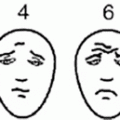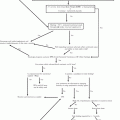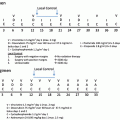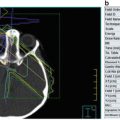Incidence of NHL per million person-years
Males
Females
Age (years)
<5
5–9
10–14
15–19
<5
5–9
10–14
15–19
Burkitt
3.2
6
6.1
2.8
0.8
1.1
0.8
1.2
Lymphoblastic
1.6
2.2
2.8
2.2
0.9
1.0
0.7
0.9
DLBCL
0.5
1.2
2.5
6.1
0.6
0.7
1.4
4.9
Other (mostly ALCL)
2.3
3.3
4.3
7.8b
1.5
1.6
2.8
3.4b
The incidence of the NHL also varies according to the histological subtype and there are very definite subgroups of patients who develop specific types on NHL. NHL is much more common in males in all age groups as well as the subtypes. Burkitt lymphoma (BL) is more prevalent in children between 5 and 15 years of age while lymphoblastic lymphoma (LL) is spread evenly over all the age groups. The other subtypes, anaplastic large cell lymphoma (ALCL) and diffuse large B-cell lymphoma (DLBCL), tend to occur in older patients and are seldom seen in younger children.
The incidence of lymphoma also varies in different areas of the world and in Africa there is a high incidence of BL and in Nairobi almost 52 % of childhood cancers are lymphoma with BL making up 34 % of these cases [5]. Similar high incidences are also seen in Uganda.
A paper from Pakistan [6] showed that median age for their patients with NHL was just over 8 years of age; there was a male predominance of 3:1 and 78 % of their children had BL.
A similar study from Baghdad [7] showed that NHL accounted for 19 % of all their childhood cancer cases: 90 % were non-lymphoblastic and treated on B-cell protocols. Again there was a male predominance of 2:1 while their age was lower between 5 and 7 years. More than 90 % of their patients had stage 3 or 4 disease.
In South America [8] it was shown that they also had a male predominance while they had a lower incidence of BL, 50 %, while LL accounted for 30 % of the cases. The majority of their patients had high-stage disease.
The aetiology of NHL is largely unknown but certain agents have been implicated in the aetiology. The best known is the link between Epstein–Barr virus (EBV), malaria and climate and BL that was elucidated by Denis Burkitt and Anthony Epstein who then discovered the EBV virus which bears his name. Other suggested agents have included toxins, pesticides and previous chemotherapy. The human deficiency virus (HIV) is associated with an increased incidence of lymphoma and a 100-fold increase in NHL is seen in HIV-infected persons [2].
Immunodeficiency, whether on a genetic basis or post transplant, has also been associated with an increase in NHL.
In Africa most of the cases are due to endemic BL and a high incidence is seen in equatorial areas of Africa.
Pathological Classification
The 2008 World Health Organization (WHO) Classification of Tumours of Haematopoietic and Lymphoid Tissues is shown in Table 19.2 [6]. However, NHL in childhood is usually classified based on morphologic, immunophenotypic, genetic features and clinical presentation. The main histological subtypes in pediatric patients are Burkitt and Burkitt-like lymphoma, DLBCL, lymphoblastic lymphoma and ALCL [10–12]. Their distribution in the United Kingdom is as follows:
Table 19.2
WHO classification of lymphoid neoplasms (2008)
Precursor lymphoid neoplasms |
B lymphoblastic leukemia/lymphoma |
B lymphoblastic leukemia/lymphoma, NOS |
B lymphoblastic leukemia/lymphoma with recurrent genetic abnormalities |
B lymphoblastic leukemia/lymphoma with t (9; 22)(q34;q11.2); BCR-ABL1 |
B lymphoblastic leukemia/lymphoma with t (v; 11q23); MLL rearranged |
B lymphoblastic leukemia/lymphoma with t (12:21)(p13;q22); TEL-AML1 (ETV6-RUNX1 |
B lymphoblastic leukemia/lymphoma with hyperploidy |
B lymphoblastic leukemia/lymphoma with hypodiploidy (hypodiploidy ALL) |
B lymphoblastic leukemia/lymphoma with t (5; 14) (q31;q32); IL3-IGH |
B lymphoblastic leukemia/lymphoma with t (1; 19)(q23;p13.3); E2A-PBX1 (TCF3-PBX1) |
B lymphoblastic leukemia/lymphoma |
T lymphoblastic leukemia/lymphoma |
Mature B-cell neoplasms |
Chronic lymphocytic leukemia/small lymphocytic lymphoma |
B-cell prolymphocytic leukemia |
Splenic marginal zone lymphoma |
Hairy cell leukemia |
Splenic lymphoma/leukemia, unclassifiable |
Splenic diffuse red pulp small B-cell lymphomaa |
Hairy cell leukemia-varianta |
Lymphoplasmacytic lymphoma |
Waldenström macroglobulinemia |
Heavy chain diseases |
Alpha heavy chain disease |
Gamma heavy chain disease |
Mu heavy chain disease |
Plasma cell myeloma |
Solitary plasmacytoma of bone |
Extraosseous plasmacytoma |
Extranodal marginal zone B-cell lymphoma of mucosa-associated |
lymphoid tissue (MALT lymphoma) |
Nodal marginal zone B-cell lymphoma (MZL) |
Pediatric type nodal MZL |
Follicular lymphoma |
Pediatric type follicular lymphoma |
Primary cutaneous follicle centre lymphoma |
Mantle cell lymphoma |
Diffuse large B-cell lymphoma (DLBCL), not otherwise specified |
T cell/histiocyte-rich large B-cell lymphoma |
DLBCL associated with chronic inflammation |
Epstein–Barr virus (EBV) + DLBCL of the elderly |
Lymphomatoid granulomatosis |
Primary mediastinal (thymic) large B-cell lymphoma |
Intravascular large B-cell lymphoma |
Primary cutaneous DLBCL, leg type |
ALK+ large B-cell lymphoma |
Plasmablastic lymphoma |
Primary effusion lymphoma |
Large B-cell lymphoma arising in HHV8-associated multicentric |
Castleman disease |
Burkitt lymphoma |
B-cell lymphoma, unclassifiable, with features intermediate between diffuse large B-cell lymphoma and Burkitt lymphoma |
B-cell lymphoma, unclassifiable, with features intermediate between |
diffuse large B-cell lymphoma and classical Hodgkin lymphoma |
Hodgkin lymphoma |
Nodular lymphocyte-predominant Hodgkin lymphoma |
Classical Hodgkin lymphoma |
Nodular sclerosis classical Hodgkin lymphoma |
Lymphocyte-rich classical Hodgkin lymphoma |
Mixed cellularity classical Hodgkin lymphoma |
Lymphocyte-depleted classical Hodgkin lymphoma |
The mature T-cell and NK-cell neoplasms |
T-cell prolymphocytic leukemia |
T-cell large granular lymphocytic leukemia |
Chronic lymphoproliferative disorder of NK-cellsa |
Aggressive NK-cell leukemia |
Systemic EBV+ T-cell lymphoproliferative disease of childhood (associated with chronic active EBV infection) |
Hydroa vacciniforme-like lymphoma |
Adult T-cell leukemia/lymphoma |
Extranodal NK/T-cell lymphoma, nasal type |
Enteropathy-associated T-cell lymphoma |
Hepatosplenic T-cell lymphoma |
Subcutaneous panniculitis-like T-cell lymphoma |
Mycosis fungoides |
Sézary syndrome |
Primary cutaneous CD30+ T-cell lymphoproliferative disorder |
Lymphomatoid papulosis |
Primary cutaneous anaplastic large cell lymphoma |
Primary cutaneous aggressive epidermotropic CD8+ cytotoxic |
T-cell lymphomaa |
Primary cutaneous gamma-delta T-cell lymphoma |
Primary cutaneous small/medium CD4+ T-cell lymphomaa |
Peripheral T-cell lymphoma, not otherwise specified |
Angioimmunoblastic T-cell lymphoma |
Anaplastic large cell lymphoma (ALCL), ALK+ |
Anaplastic large cell lymphoma (ALCL), ALK–a |
Burkitt and Burkitt-like lymphoma/leukemia | 42.2 % |
Lymphoblastic lymphoma | 27.2 % |
ALCL | 15 % |
Others | 15.6 % |
Most of the other NHLs in the various classifications are not common in Pediatrics. The most recent WHO classification has identified pediatric follicular lymphoma and pediatric nodal marginal zone lymphoma as unique entities.
Burkitt Lymphoma
Microscopically, BL is characterized by a diffuse infiltrative pattern, and the medium- to small-sized cells are homogenous with round to ovoid nuclei, 1–3 prominent basophilic nucleoli and basophilic cytoplasm that usually contain fat vacuoles. BL is histologically characterized by a “starry sky” appearance, representing scattered macrophages that have phagocytosed cell debris among proliferating lymphoma cells. The malignant cells show a mature B-cell phenotype and are negative for the enzyme deoxy nucleotidyl transferase (TdT). The cells express surface immunoglobulin, most bearing surface immunoglobulin M with either kappa or lambda light chains. Cell markers that are usually present include CD20+, BCL6+, CD10+ and BCL2−. Expression of the proliferation antigen Ki-67 is observed in virtually all the tumour cells. BL/leukemia expresses a characteristic chromosomal translocation, usually t(8:14) or t(8:22) or t(2;8) [10]. Each of these translocations juxtaposes the c-myc oncogene and immunoglobulin locus regulatory elements, resulting in the inappropriate expression of c-myc, a gene involved in cellular proliferation. Cytogenetic evidence of c-myc rearrangement is the gold standard for diagnosis of BL. The 2008 WHO classification eliminated the variant category of “atypical BL,” which had been included in the 2001 classification. Thus, a case with the typical BL phenotype (CD20+, BCL6+, CD10+, BCL2–) and genotype (so-called MYC-simple or MYC/IG in the absence of other major cytogenetic anomalies) may be classified as BL, even if there is some cytological variability in the morphology of the neoplastic cells [6, 9]. For cases in which cytogenetic analysis is not available, the WHO has recommended that the Burkitt-like diagnosis be reserved for lymphoma resembling BL or with more pleomorphism, large cells and a proliferation fraction (i.e. Ki-67[+] of ≥99 %) [11].
Diffuse Large B-Cell Lymphoma
These are proliferations of large lymphoid cells of B-cell lineage with nuclei at least twice the size of small lymphocytes [14]. The normal architecture of the nodal or extranodal tissue is diffusely replaced with frequent extension into perinodal soft tissues. The malignant cells express pan-B markers including CD19, CD20, CD22 and CD79a with surface immunoglobulin expression in more than half of the cases [14]. The vast majority of pediatric diffuse large B-cell lymphoma cases have a germinal centre B-cell phenotype, as assessed by immunohistochemical analysis of selected proteins found in normal germinal centre B cells, such as the BCL6 gene product and CD10 [15]. About 20 % of pediatric diffuse large B-cell lymphoma presents as primary mediastinal disease (primary mediastinal B-cell lymphoma.
Lymphoblastic Lymphoma
In lymphoblastic lymphomas, the cells are homogenous with scant cytoplasm, round to oval nuclei, with finely stippled chromatin and inconspicuous nucleoli. Lymphoblastic lymphomas are usually positive for TdT, with more than 75 % having a T-cell immunophenotype and the remainder having a precursor B-cell phenotype [10, 16].
Anaplastic Large Cell Lymphoma
The tumours appear as a proliferation of cohesive large, bizarre, pleomorphic cells with abundant cytoplasm (more than most lymphomas) with eccentric horseshoe-shaped nuclei with multiple or single prominent nucleoli [14]. While the predominant immunophenotype of ALCL is mature T-cell, null-cell disease (i.e. no T-cell, B-cell or NK-cell surface antigen expression) does occur. All ALCL cases are CD30+ and more than 90 % of pediatric ALCL cases have a chromosomal rearrangement involving the ALK gene [17]. The category of ALCL in the 2001 WHO classification included both ALK+ and ALK− tumours and excluded primary cutaneous-ALCL. The 2008 classification concluded that current evidence warranted delineation of ALK+ ALCL as a distinct entity. ALK+ ALCL occurs mainly in pediatric and young age groups, has a better prognosis than ALK− ALCL, and exhibits differences in genetics [18].
Clinical Features
The clinical features of NHL depend on the site affected and the histological subtype. Although, low- and intermediate-grade malignant tumours predominate in adults, more than 90 % of children with NHL have high-grade malignant tumours with a propensity for malignant dissemination [19]. At least 60 % of children have advanced disease (stage III or IV) at diagnosis (Table 19.3) [10, 19]. Childhood NHL is predominantly an extranodal disease with primary sites involving the abdomen in 31 % of cases, mediastinum in 26 % of cases, head and neck region (including Waldeyer’s ring and cervical nodes) in 29 % of cases. Only 6.5 % present with peripheral nodes outside the neck [20]. While most of the abdominal tumours are B-cell lymphomas, most mediastinal tumours are T-cell lymphomas [19]. Manifestations of abdominal tumour include pain, abdominal masses, nausea and vomiting resulting from intestinal obstruction caused by direct compression of the bowel lumen or by intussusceptions. NHL is the commonest cause of intussusceptions in children older than 6 years of age. Patients with large abdominal masses are at risk for the tumour lysis syndrome on initiation of chemotherapy [10]. Common clinical features of non-Hodgkin’s lymphoma are shown in Table 19.3.
Table 19.3
Common clinical features of childhood non-Hodgkin’s lymphoma
Clinical feature | Cause |
|---|---|
General features | |
Fever | Release of cytokines, infections |
Weight loss | Inflammatory cytokine production, acute phase protein response, anorexia |
Peripheral lymphadenopathy | Malignant transformation, metastasis |
Abdomen | |
Abdominal pain and swelling | Ovarian, retroperitoneal, kidney and intestinal masses |
Nausea, vomiting, constipation | Intussusception, infections |
Hepatosplenomegaly | |
Chest | |
Respiratory distress/cough | Mediastinal masses with airway compression, pleural effusion |
Swelling of the neck, face and arms | Superior vena obstruction by masses |
Skin and soft tissue infiltration | Tumour infiltration |
Jaw | |
Jaw swelling with intra-oral extension, “dental anarchy” (misalignment) | Maxilla more affected than mandible in Burkitt lymphoma |
Proptosis | Orbital tumour |
Nervous system | |
Paraplegia—usually flaccid | Spinal cord invasion |
Cranial nerve palsies | Central nervous system involvement |
Lymphoblastic Lymphoma
This is mostly of a T-cell immunophenotype and typically presents as a mediastinal mass, often with an associated pleural effusion. Large mediastinal masses may manifest as severe respiratory distress resulting from airway compression or swelling of the neck, face and arms due to obstruction of the superior vena cava [10]. Lymphoblastic lymphoma may also affect the liver and spleen although isolated primary involvement of the abdomen is rare [10]. Patients may also present with peripheral lymphadenopathy and infiltration of the skin and soft tissues [13].
Anaplastic Large Cell Lymphoma
ALCL may affect nodal as well as extranodal sites. As much as 70 % of patients present with peripheral lymphadenopathy, the commonest site being cervical. Other sites involved include bones, soft tissue or skin, mediastinum or lungs [13]. The skin is the commonest extranodal site [21]. B symptoms such as fever and weight loss are also common in ALCL but relatively uncommon in other forms of NHL.
Burkitt Lymphoma
Burkitt lymphoma (BL) is characterized by a very short doubling time of 24 h and the interval from initiating or promoting events to diagnosis may be comparatively short. There are three clinico-epidemiologic forms of BL namely endemic, sporadic and HIV-associated types.
The jaw is the most commonly affected site in endemic BL; in high-incidence areas up to 90 % of patients may have clinical or subclinical jaw (radiographic abnormalities) involvement [22]. After the jaw the abdomen is the second commonest site of involvement of endemic BL; intra-abdominal structures are involved in 50–60 % of cases. Some parts of Nigeria like Ibadan have however reported a predominance of abdominal sites above jaw in endemic BL [23]. Other sites affected in the endemic tumour include the orbit, ovaries, retroperitoneal structures, kidneys, omentum, bowel wall and the central nervous system. CNS involvement includes cranial nerve palsies, paraplegia (usually flaccid) and malignant CSF pleocytosis. Only 25 % of patients with cranial nerve palsies have CSF pleocytosis. Invasion of the brain parenchyma is rare. Other sites that may be affected in endemic BL are pleura, endocrine and salivary glands, testes, bone and skin [22].
Unlike endemic BL which peaks at 7 years, a recent study on sporadic BL in the United States has showed two separate peaks among males and females, around the ages 10 and 75 years, and a 3rd peak around the age 40 years among males [24]. Previous reports had indicated that the predominant primary site of sporadic BL was the abdomen [20, 22]. A study in the United States that covered the period 1992–2005 revealed that BL tumours most frequently arose in the lymph nodes (56 %); the abdomen (21 %, primarily in the small or large intestine) is now the second most common site [25]. Other sites of involvement of sporadic BL are bone marrow (14 %, also called Burkitt cell leukemia), the oral cavity and the oropharynx [25]. While central nervous system involvement tends to be more common in endemic BL, bone marrow involvement is more common in the sporadic form.
In Uganda where BL is endemic, the frequency of jaw tumours in HIV-positive children is similar to that in HIV-negative children at presentation [26]. However in addition HIV-positive children presented significantly more often with extra-facial disease (lymphadenopathy 67 %, hepatic masses 51 % and thoracic masses 10 %). HIV-associated BL also present more frequently with advanced stage disease than HIV-negative cases [26].
Diffuse Large B-Cell Lymphoma
DLBCL presents similarly to BL with abdominal presentation being common. However, compared to BL patients, children with DLBCL more frequently present with localized disease, focal lesions in liver, spleen, lung and a mediastinal mass. Bone marrow and central nervous system involvement is also less common in DLBCL compared with other NHL entities [27].
Staging
The most widely used staging scheme for childhood non-Hodgkin lymphoma is that of the St. Jude Children’s Research Hospital also known as Murphy Staging [19].
Bone marrow involvement has been defined as 5 % malignant cells in an otherwise normal bone marrow with normal peripheral blood counts and smears. Patients with lymphoblastic lymphoma with more than 25 % malignant cells in the bone marrow are usually considered to have leukemia and may be appropriately treated on leukemia protocols.
CNS disease in lymphoblastic lymphoma is defined by criteria similar to that used for acute lymphocytic leukemia (i.e. white blood cell count of at least 5/μL and malignant cells in the cerebrospinal fluid [CSF]). For any other NHL, the definition of CNS disease is any malignant cell present in the CSF regardless of cell count.
However, the St. Jude’s staging classification is unclear on the definition of extensive primary disease and considers all primary abdominal and thoracic tumours as extensive stage III disease, despite original surgical debulking, which may occur at diagnosis. Subsequently, a new French, American and British (FAB) staging classification was developed (Table 19.4) that better defines the staging of childhood B large cell and BL of childhood [28]. This system recognizes the common dissemination to either the central nervous system or bone marrow and the fact that this is indicative of a poor prognosis (Table 19.5).
Table 19.4
Murphy staging of childhood non-Hodgkin lymphoma
Stage I |
A single tumour (extranodal) or single nodal area is involved, with the exclusion of the abdomen and mediastinum |
Stage II |
A single tumour with regional node involvement |
Two or more nodal areas involved on same side of the diaphragm |
Two single (extranodal) tumours with or without regional node involvement on same side of diaphragm |
A primary gastrointestinal tract tumour (completely resected) with or without regional node involvement |
Stage III |
Two single tumours (extranodal) on both sides of the diaphragm |
Two or more nodal areas on both sides of the diaphragm |
All primary intrathoracic (mediastinal, pleural or thymic) disease, extensive primary intra-abdominal disease, or any paraspinal or epidural tumours, regardless of other tumour site(s). |
Stage IV |
Any of the above with initial involvement of the bone marrow and/or central nervous system (CNS) |
Table 19.5
FABa staging system for childhood B large and Burkitt lymphoma
Group A |
Completely resected Stage I (St. Jude) |
Completely resected abdominal Stage II (St. Jude) |
Group B |
All patients not eligible for Group A or Group C |
Group C |
Any CNS involvementb and/or bone marrow involvement (≥25 % blasts) |
BL constitutes the majority of NHL in equatorial Africa. BL in Africa is frequently staged according to a staging system previously described by Magrath et al. [29] based on survival in patients with BL at the Lymphoma Treatment Centre (LTC) in Uganda. This system has recently been used in a multicentre study of African BL by the International Network for Cancer treatment and Research (INCTR) and renamed the LTC system (Table 19.6) [30]. It is useful in resource-constrained places like Africa where the Murphy system cannot be applied due to lack of expertise and facilities for performance of bone marrow aspiration cytology and cerebrospinal fluid examination.
Table 19.6
LTC staging system for Burkitt lymphoma
Stage A: a single extra-abdominal tumour |
Stage B: multiple extra-abdominal tumours (including CNS involvement, i.e. CSF pleocytosis or cranial nerve palsies) |
Stage C: abdominal tumour with or without facial tumours |
Stage D: abdominal tumour with tumour at any other site or sites, except the face alone |
Differential Diagnosis
A number of childhood conditions including infections like tuberculosis might mimic non-Hodgkin lymphoma in their presentation (Table 19.7). Therefore a high grade of suspicion and appropriate laboratory investigations are required to confirm the diagnosis.
Table 19.7
Differential diagnoses of non-Hodgkin’s lymphoma in childhood
Disease | Important similarities and distinctions |
|---|---|
Hodgkin lymphoma | May present with lymphadenopathy most commonly cervical, mediastinal masses, hepatosplenomegaly, fever, weight loss similar to NHL. May also cause superior vena caval syndrome |
Rhabdomyosarcoma | May present with orbital, jaw and abdominal swellings, paraplegia similar to Burkitt lymphoma |
Neuroblastoma | May present with proptosis, jaw swelling, abdominal swelling and paraplegia similar to NHL. However, more often affects children under 5 years of age, associated with scalp swellings and proptosis usually bilateral |
Nephroblastoma | May present with abdominal swelling and respiratory symptoms due to pulmonary metastasis but mostly affects children under 5 years of age |
Tuberculosis | May present with cough, fever, drenching night sweats, weight loss and lymphadenopathy. Abdominal distension may be present. Paraplegia when present is usually spastic and associated with a gibbus. Chest radiograph may show parenchymal opacities, cavities, effusion, hilar adenopathy |
Human immunodeficiency virus infection | May present with fever, cough, weight loss, respiratory symptoms and signs, generalized lymphadenopathy, hepatosplenomegaly. HIV test will be positive but may coexist with lymphoma so tissue biopsy is necessary to exclude lymphoma |
Diagnostic Work Up
The following investigations are required for the diagnostic work up of children with non-Hodgkin lymphoma.
Laboratory Tests
Complete blood count
Serum electrolytes, blood urea nitrogen, creatinine, calcium, phosphorus, uric acid
Liver function tests (serum bilirubin, ALT, AST, alkaline phosphates, serum albumin and total protein)
Lactic dehydrogenase level
Viral studies: Hepatitis B and C serology, HIV antibody, HSV antibody, CMV antibody, varicella antibody
Confirmatory Tests
Pathological diagnosis is required for confirmation of diagnosis.
Surgical tissue biopsy for histology, immunologic, cytogenetic and molecular studies
Needle aspirate for cytology (tissue biopsy is usually more informative and preferred to needle aspirate [32].
Stay updated, free articles. Join our Telegram channel

Full access? Get Clinical Tree







